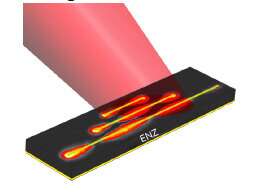Designing next-generation optical antennas

Antennas catch radio waves, a form of electromagnetic radiation, from the air and convert the energy into electrical signals that feed modern telecommunications. They can also convert electrical signals into radio waves. Without antennas, the world would be a much different place than it is today. Optical engineers and scientists like Anthony J. Hoffman, associate professor in the Department of Electrical Engineering at the University of Notre Dame, are working toward leveraging these devices to control light instead of radio waves.
Hoffman has been focusing his efforts on next-generation materials, technologies and devices for infrared light. Most often associated with night vision, infrared light has many uses in optical sensing and detection. Optical antennas enable engineers to control how light interacts with materials and can localize light to subwavelength dimensions for use with many of today's nanoscale devices.
The paper, titled "Monochromatic Multimode Antennas on Epsilon-Near-Zero Materials," recently published in Advanced Optical Materials, describes a special class of optical materials that can drastically alter the properties of optical antennas. This "control" of properties opens the door for new ways to engineer optical antennas.
Hoffman and his co-authors—Kaijun Feng, Junchi Lu and Owen Dominguez, all graduate students in electrical engineering at Notre Dame, along with Daniel Wasserman, associate professor of electrical and computer engineering, and graduate student Leland Nordin, both of the University of Texas at Austin—worked largely in two campus facilities (the Notre Dame Nanofabrication Facility and the Notre Dame Integrated Imaging Facility) to design, fabricate and demonstrate optical antennas using an epsilon-near-zero (ENZ) material.
ENZ materials offer unique phenomena, including wavefront engineering, enhanced light funneling through subwavelength apertures, order-of-magnitude extension of the local wavelength in waveguiding structures, and spectrally-selective absorption and thermal emissions. Building optical antennas on an ENZ material allowed the team to design and demonstrate a multimode, nearly monochromatic antenna, a new class of optical antennas, that could have use in sensing, imaging, infrared optoelectronics and thermal emission control applications. It also offers the potential of new types of optical devices.
Hoffman, an affiliated member of the Center for Nano Science and Technology, and his team are currently working to incorporate their optical antennas into semiconductor devices in order to improve the interaction between light and semiconductor materials, thus creating the next generation of infrared sources.
More information: Owen Dominguez et al. Monochromatic Multimode Antennas on Epsilon-Near-Zero Materials, Advanced Optical Materials (2019). DOI: 10.1002/adom.201800826
Journal information: Advanced Optical Materials
Provided by University of Notre Dame





















